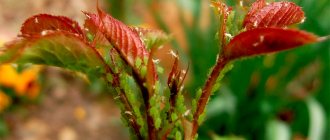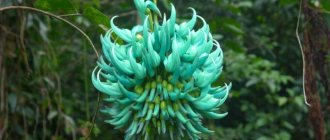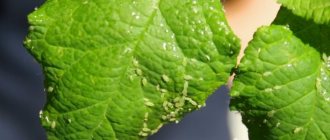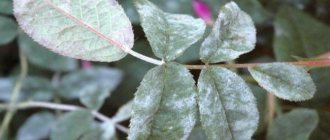The topic of how to deal with whiteflies in a greenhouse is of interest not only to novice gardeners, but also to people who have extensive experience in plant growing. The rapid reproduction of the insect leads to the fact that the plant does not receive enough moisture and useful components and begins to wither. There are many ways to get rid of it, from manual collection or spraying with pesticides, to setting up traps or introducing antagonistic insects (predators).
Tomatoes affected by whitefly Source stopklopu.com
What does a whitefly look like?
The whitefly, or aleurodida, is a flying insect from the family of small Homoptera. In total, there are about 1,500 species of this insect in nature, and in our latitudes only 20 of its varieties can be found.
The whitefly is somewhat reminiscent of a moth or moth with its wings folded in the shape of a house. Its size does not exceed 3 millimeters in length. The insect is completely white with a small yellow head. The wings are covered with fine white pollen.
Description and life cycle of the pest
Whitefly is a dangerous and common pest. This insect looks like a white moth. Adult whiteflies have a flat, oval body, yellow-red, greenish or white, 2-3 mm long. Two pairs of narrow wings are covered with a white waxy coating. These insects are very reactive, and when the leaves are shaken, large numbers of flies quickly fly up.
More than 1,500 species belong to the pest family. The biggest nuisance for greenhouse and home gardeners is the greenhouse whitefly. This is a polyphagous insect native to South America, omnivorous and voracious, like a locust. This insect loves a warm and humid microclimate. In such conditions, the whitefly reproduces all year round.
In the garden you can find strawberry whitefly, cabbage whitefly and honeysuckle whitefly. These species are less dangerous because they are not as widespread as greenhouse species and do not destroy crops en masse. In the southern regions, tobacco and citrus whiteflies are harmful.
In open ground, the pest is active only in summer. The insect overwinters as larvae and eggs, laying them in secluded places such as unheated greenhouses, in the soil or under the bark of trees.
The peak of rapid reproduction occurs in summer. Females lay 20 to 280 gray ring-shaped eggs on the underside of the leaf. After 1.5 weeks they produce translucent larvae no larger than 1 mm in size. They are the most harmful to plants.
At the next stage, the larvae develop into nymphs, from which adults (imago) emerge after 6 days. The complete cycle from larval to adult stage takes 3 to 4 weeks. About 80-90% of larvae survive to the butterfly stage.
The next generation also produces offspring. The reproductive cycle is repeated several times during the summer. The pest can be present at all stages of development on the same plant. At an average temperature of 18-24°C, the whitefly lives 17-24 days. If the temperature rises to 30°C, the service life is reduced to 4 days.
How to detect whitefly
Before you think about how to get rid of this pest, you need to figure out how to detect it. After all, the sooner you notice traces of the appearance of whiteflies, the fewer consequences you can deal with.
Most often, whiteflies can be detected by the following signs:
- the plant has sharply slowed down its growth and development, the leaves turn yellow and curl
- white spots appeared on the leaves, which over time changed their color to dark - this is a fungal disease that often infects the plant with whitefly
- the inside of the plate is covered with a sticky coating
- the inner side is covered with small transparent scales, the remains of cocoons or insect eggs
If there is no visible damage, but neighboring plants are already affected, take a simple pencil and lightly hit each leaf. If the whitefly has already infested the plants, after such shocks you will see tiny white insects falling from the leaves on the ground.
The insect is small, but the trouble is big
The danger of whiteflies lies not only in the devouring of strawberries by adults and larvae. Despite their simply huge and insatiable appetite, insects are not able to assimilate all the plant juice they consume, and therefore excrete a special waste product. Visually it looks like dew. And this is simply an ideal environment for the development of a dangerous fungus, which is popularly called mob.
This disease is no less dangerous for garden crops than whitefly. The fungus is able to completely clog the holes in the green part of the plant. This leads to the inevitable cessation of photosynthesis. As a result, the plant withers and dies within a short period of time.
Some gardeners are inclined to believe that flies are found only in open areas. In reality, this opinion is wrong, and whiteflies can be found even in greenhouses. Moreover, greenhouses are an ideal habitat for pests. After all, there is a high level of humidity and constant warmth - what else can you dream of?
Where does the whitefly come from?
Whitefly can attack a plant in open ground, in a greenhouse, and even indoors. Even if the appearance of this insect in these specific conditions seems impossible, the whitefly can always find its way to the plant through:
- Soil. Most often, there are already eggs of this pest in the garden soil, and by placing the plant in greenhouse or indoor conditions, you can speed up the process of the appearance of the pest
- Window. Even mosquito nets will not stop the whitefly; its size allows it to climb into any hole
- Infected sprout. Cuttings shared by gardeners may already be infested with whitefly larvae.
The insect loves hot rooms where there is no good ventilation.
Whitefly eggs can wait a long time until the temperature and conditions they need are established, and only then turn into insects. At the same time, the whitefly cannot tolerate the cold and dies at temperatures below 10 degrees Celsius.
What kind of midges grow on personal plots?
The term summer midge can hide two types of pests:
Representatives of both species are very prolific, harmful, and controlling them can be very difficult.
black midge
This type of pest includes two subspecies of midges: with and without wings. They live mainly in tomato beds, sitting on the bushes in a dense layer. As was already said, such midges reproduce very quickly and also quickly disperse throughout the garden. Damaged bushes wither and die over time.
To prevent black midges from entering the garden, experienced summer residents advise planting plants around the perimeter of tomato beds that will attract its natural enemies: wasps, ladybugs, hoverflies and lacewings. In addition to fragrant herbs, it is advisable to plant dill, garlic, onions and calendula on the site - midges really do not like their aroma, and therefore rarely settle near them. It also wouldn’t hurt to inspect the area and destroy any anthills found on it. This measure is necessary due to the fact that ants feed on the secretion secreted by black flies, and therefore protect them from other insects.
White midge
White midges are found mainly in greenhouses. She settles on the back of the leaves, where she lays her eggs. Over time, larvae emerge from the eggs, which, feeding on plant juices, cause great harm to them.
Determining that a crop is infected is quite simple - all you have to do is pay attention to its appearance. On plants affected by white midges, the leaves begin to curl, the fruits ripen unevenly and many become white inside, a whitish coating is visible on the foliage, which turns black after a while, and despite proper watering, the green parts of the bush gradually turn yellow. In order to make sure that it was the white midge that attacked the plant, you just need to touch it, and the pests on it will immediately fly away.
Important! Bushes affected by whitefly quickly weaken and become vulnerable to pathogens of viral, bacterial and fungal diseases!
Since the white midge loves moisture very much, it rarely appears in the garden. This parasite lives mainly in greenhouses, where conditions that are comfortable for it are always present. And in order to prevent the spread of the pest, it is necessary, first of all, to plant the seedlings not very densely. In addition, it is very important to ensure good air circulation in the greenhouse and to strengthen the beds with fertilizers.
Prevention measures
It is easier to prevent the appearance of whiteflies than to later look for means to combat this pest. To avoid this threat, you must:
- fertilize the plant during planting and during growth and flowering
- do not plant plants close to each other
- do not fertilize the plant in the cold season
- monitor indoor air humidity
- provide fresh air access to the room, ventilate it
If, despite proper care of the plants, the pest still appears, it is necessary to select the optimal remedy for whiteflies.
Preventive actions
No wonder there is a popular wisdom: the best defense is an attack. Therefore, any lover of garden crops interested in growing strawberries and other berries needs to prepare in advance for the upcoming attack from natural profit lovers.
It is optimal to place onion or garlic plantings between the rows - they emit a pungent and unpleasant odor for insects, which will avoid this place. True aesthetes should take a closer look at marigolds and nasturtiums. Small parasites also cannot stand the smell of these flowers.
Important! Since the damage from the miniature pest is very great, it is necessary to carefully inspect the young bush before planting it for the presence of uninvited guests. The main reason for the mass death of plantings is the acquisition of an infected seedling/
A similar effect can be achieved by using wood ash. To repel pests, you should scatter it near the bushes. In addition, it is useful to give the culture a hot shower every month. The water is heated to 80 °C, and the plants are watered from a watering can.
Chemicals against whiteflies
When choosing effective pest control products, you need to pay attention to the safety of use in enclosed spaces. For example, insecticides are considered the most effective, but when treating plants, you cannot stay indoors for a long time.
The most common means are:
- Mospilan. Single spraying 0.05-0.06 g
- Actellik. One ampoule per liter of water to treat 5 square meters
- Confidor. 0.1 ml per liter of water and spray once
- Fufanon. 1.5 ml - one-time spraying
Rules for processing plants
In order to ruthlessly destroy whiteflies on strawberries by using chemicals, you must adhere to certain rules:
- Strictly follow the dosage prescribed by the manufacturers in the instructions!
- Spraying the crop should be carried out only in dry and windless weather!
- Use different preparations each time so that insects cannot get used to them!
- The process of treating plants should be carried out in the early morning hours or in the evening at sunset! The sun's rays coming into contact with drops containing toxic substances can cause burns.
- With frequent and incorrect use of chemicals, their substances accumulate in the soil. Eating berries collected from cultivated areas is unsafe!
For your information! The pest leaves behind transparent tracks on the back of the leaves, which make it easy to detect. Whiteflies can also be seen upon careful inspection.
You can significantly reduce the population of adult whiteflies and their larvae in your garden in 4 procedures, taking a break of 5 days. Only with each subsequent treatment should the concentration of the drug be reduced. Only compliance with these conditions will allow you to completely get rid of pests and keep the delicacy safe for consumption.
Mechanical action against whitefly
If treatment for whiteflies with chemicals is successful, then the effect can be enhanced by mechanical means. For example, the following are effective:
- fumigators against flies and mosquitoes placed at the base of the damaged plant
- handmade traps: small pieces of plywood painted with oil paint or wrapped with double-sided tape
Once the chemical attack has been applied, such methods can help eliminate any remaining insects.
Small species of beetles
Small domestic beetles include skin beetles, grinders, and beetles. They damage various products, can feed on paper and spoil books. Carpet beetles also damage fur coats and woolen clothing.
In the photo there is a bread grinder, one of the smallest insects in the apartment:
This beetle reaches 1.5 mm in length and does not feed as an adult, although it makes passages in many products, damaging them. But its larva feeds on almost everything, including paper and fibers of semi-synthetic clothing.
Bread damaged by borer larvae becomes poisonous to humans. You can't eat it!
Very small insects, also often found in apartments - carpet beetles, capable of making holes in fur coats and furs, “cutting” carpets and eating the bindings of old books:
All of the above small beetles can be quite difficult to remove from the apartment. If their larvae are found in food, all supplies should be thrown away, and bedside tables and shelves should be treated with insecticidal agents. In cabinets and on bookshelves, things and objects are treated with aerosol insecticides, and then it is useful to place anti-moth sections here, which are quite effective against beetles.
Traditional methods of dealing with whitefly
The fight against whiteflies has been carried out by gardeners and flower growers for a very long time. Over the years, many effective recipes have appeared among the people that help get rid of this pest. The most popular of them:
Soap solution
Grate laundry soap or cut into thin shavings and dissolve in warm water in a ratio of 1:6. Apply foam from this solution to the plant and the top of the soil. Often one application is enough to ensure that the pest no longer exists. But if necessary, the procedure can be repeated after a week.
Dandelion infusion
100 grams of dandelions (with leaves and roots) are infused in a liter of water for several days. The solution must be filtered and sprayed on the plants with a spray bottle.
Tobacco infusion
All cigarettes from the pack are opened and filled with water for several days. The solution must be filtered and the plants sprayed with it from a spray bottle every few days.
Garlic infusion
Chop a few cloves, add 1 liter of water and leave for a day. Strain the solution and spray the plant with it from a spray bottle several times at intervals a week.
Yarrow infusion
Pour 100 g of yarrow into 1 liter of water and leave for several days. Strain the solution and spray the plant with it from a spray bottle several times at intervals a week.
It is known that the whitefly cannot tolerate low temperatures. Therefore, another popular method can be considered placing plants in a place where the air temperature does not currently exceed 10 degrees.
However, when using this method, it is necessary to take into account the susceptibility of the plant itself to low temperatures.
Photos of whiteflies may seem harmless, but the first impression in this case will be wrong. The damage this insect can cause is colossal. Therefore, it is necessary to detect the pest in time and quickly neutralize it.
Features of biological protection
When we fight pests using chemicals, we have to be extremely careful! Inept handling of drugs leads to various consequences. Moreover, not only plants are at risk; the gardener himself is also at risk in a certain sense.
The use of biomaterial is a more gentle solution and an alternative to chemistry. The essence of the biological technique is to intentionally introduce other insects to the garden crop, which will be beneficial by eating whitefly larvae. At the same time, the plants themselves remain safe and sound. Among such saviors we can note the two most common enemies of whiteflies:
- predatory bug Macrolophus;
- parasite of the greenhouse whitefly Encarzia.
Having completed the “cleansing”, the saviors leave the “processing” zone and move to another place. To purchase such biological material, you should contact any large garden farm or laboratory.
The Macrolophus bug is considered a true whitefly killer











